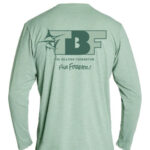Because overfished Atlantic marlin receive no government research funding priority, large data gaps relating to their life history characteristics remain. Satellite tagging provides a means to fill some of the data gaps by recording a marlin’s location and movement in the water column, both horizontal and vertical. Each tag records variables in sunlight levels, water temperature and pressure that is converted to location and movement. Movement data then provides insight to such elements as whether oil rigs, which serve as large Fish Aggregation Devices (FADs), modify marlin movements and whether marlin remain in the region all year because of the availability of abundant prey species and warm water remain year-round.

Among TBF’s research goals are closing some of the data gaps and adding to what is known about billfish life history characteristics; hence, a Gulf of Mexico Blue Marlin Satellite Tagging Expedition was scheduled. Drs. John Hoolihan, of the University of Miami, and James “Jim” Franks and Jeremy Higgs of the University of Southern Mississippi served as principal investigators leading the expedition. Each were on board a designated research boat with an angler and other team members in pursuit of blue marlin, along with many other sportfishing boats that volunteered to assist with the research. When a marlin was hooked by one of the sportfishing vessels, a science vessel moved quickly within range and a transfer of the fish was completed through the exchange of leaders and hooked fish on the research vessel. A scientist then stuck the point of the tag’s anchoring plate into the marlin’s upper muscle tissue, the crew resuscitated and released the fish with as little trauma as possible. As the tags continue to collect data over 12 months, it is ultimately uploaded to an Argos satellite. Scientists download the data, which will be analyzed and a report produced for publication and to share with Expedition participants.
The vessel Breathe Easy, owned by Matt McDonald, with Captain Patrick Ivey hooked and transferred the first marlin, which was tagged successfully by Higgs and Franks on board the boat Mojo with captain Mo Newman. During Day Two, it was again Breathe Easy that caught the second marlin, which was tagged by Hoolihan from the University of Miami onboard Triple C, owned by Scott Copper, a TBF board member. Angler Rene Cross on Miss Remy, owned by Rene Cross, caught the third, fourth, and fifth marlin tagged.
In the evenings at the new clubhouse of the New Orleans Big Game Fishing Club, participants were treated to exceptional local Louisiana seafood prepared by Cypress Cove Marina staff, with libations donated by the NOBGFC, and they enjoyed conversations with TBF staff, friends and the scientists. Louisiana’s Lieutenant Governor Billy Nungesser joined the last night’s event to show his interest in the tagging research for he wants to learn how it can assist in sustainable management and conservation of marlin, thus helping promote recreational blue marlin fishing off Louisiana. As a gesture of appreciation for Expedition participants, many coming from other states, the Lieutenant Governor provided for the last evening’s dinner a most impressive array of local Louisiana seafood, proudly donated from the Louisiana Seafood Promotion Board, to showcase and promote some of the state’s other fine resources. All the “plugs were pulled” by Cypress Cove Marina in preparing and serving the donated seafood; a feast was enjoyed by all.
 Additional TBF satellite tagging expeditions will be scheduled in the near future. If anyone is interested in purchasing a tag and participating, please contact Johnny Dorland or Ellen Peel. The purchase of a tag through a donation to TBF is tax-deductible and must be used in a planned expedition.
Additional TBF satellite tagging expeditions will be scheduled in the near future. If anyone is interested in purchasing a tag and participating, please contact Johnny Dorland or Ellen Peel. The purchase of a tag through a donation to TBF is tax-deductible and must be used in a planned expedition.
The Billfish Foundation is a certified 501(c)3 nonprofit dedicated to conserving billfish and the communities dependent upon them. To stay up-to-date on all things billfish and be a part of conservation efforts, become a member, subscribe to our monthly newsletter, or follow us on social media, @TheBillfishFoundation.






